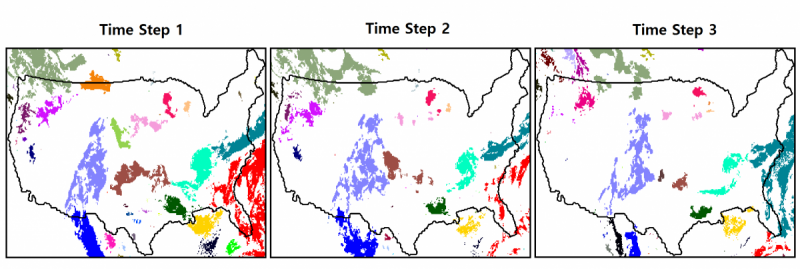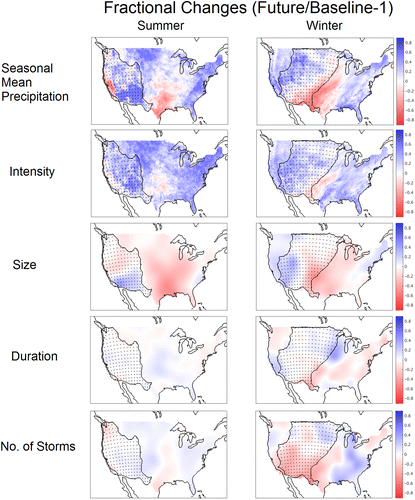Climate change will drive stronger, smaller storms in US

The effects of climate change will likely cause smaller but stronger storms in the United States, according to a new framework for modeling storm behavior developed at the University of Chicago and Argonne National Laboratory. Though storm intensity is expected to increase over today's levels, the predicted reduction in storm size may alleviate some fears of widespread severe flooding in the future.
The new approach, published today in Journal of Climate, uses new statistical methods to identify and track storm features in both observational weather data and new high-resolution climate modeling simulations. When applied to one simulation of the future effects of elevated atmospheric carbon dioxide, the framework helped clarify a common discrepancy in model forecasts of precipitation changes.
"Climate models all predict that storms will grow significantly more intense in the future, but that total precipitation will increase more mildly over what we see today," said senior author Elisabeth Moyer, associate professor of geophysical sciences at the University of Chicago and co-PI of the Center for Robust Decision-Making on Climate and Energy Policy (RDCEP). "By developing new statistical methods that study the properties of individual rainstorms, we were able to detect changes in storm frequency, size, and duration that explain this mismatch."
While many concerns about the global impact of climate change focus on increased temperatures, shifts in precipitation patterns could also incur severe social, economic, and human costs. Increased droughts in some regions and increased flooding in others would dramatically affect world food and water supplies, as well as place extreme strain on infrastructure and government services.
Most climate models agree that high levels of atmospheric carbon will increase precipitation intensity, by an average of approximately 6 percent per degree temperature rise. These models also predict an increase in total precipitation; however, this growth is smaller, only 1 to 2 percent per degree temperature rise.
Understanding changes in storm behavior that might explain this gap have remained elusive. In the past, climate simulations were too coarse in resolution (100s of kilometers) to accurately capture individual rainstorms. More recently, high-resolution simulations have begun to approach weather-scale, but analytic approaches had not yet evolved to make use of that information and evaluated only aggregate shifts in precipitation patterns instead of individual storms.

To address this discrepancy, postdoctoral scholar Won Chang (now an assistant professor at the University of Cincinnati) and co-authors Michael Stein, Jiali Wang, V. Rao Kotamarthi, and Moyer developed new methods to analyze rainstorms in observational data or high-resolution model projections. First, the team adapted morphological approaches from computational image analysis to develop new statistical algorithms for detecting and analyzing individual rainstorms over space and time. The researchers then analyzed results of new ultra-high-resolution (12 km) simulations of U.S. climate performed with the Weather Research and Forecasting Model (WRF) at Argonne National Laboratory.
Analyzing simulations of precipitation in the present (2002-2011) and future (years 2085-2094), the researchers detected changes in storm features that explained why the stronger storms predicted didn't increase overall rainfall as much as expected. Individual storms become smaller in terms of the land area covered, especially in the summer. (In winter, storms become smaller as well, but also less frequent and shorter.)
"It's an exciting time when climate models are starting to look more like weather models," Chang said. "We hope that these new methods become the standard for model evaluation going forward."
The team also found several important differences between model output and present-day weather. The model tended to predict storms that were both weaker and larger than those actually observed, and in winter, model-forecast storms were also fewer and longer than observations. Assessing these model "biases" is critical for making reliable forecasts of future storms.
"While our results apply to only one model simulation," Moyer said, "we do know that the amount-intensity discrepancy is driven by pretty basic physics. Rainstorms in every model, and in the real world, will adjust in some way to let intensity grow by more than total rainfall does. Most people would have guessed that storms would change in frequency, not in size. We now have the tools at hand to evaluate these results across models and to check them against real-world changes, as well as to evaluate the performance of the models themselves."
New precipitation forecasts that include these changes in storm characteristics will add important details that help assess future flood risk under climate change. These results suggest that concerns about higher-intensity storms causing severe floods may be tempered by reductions in storm size, and that the tools developed at UChicago and Argonne can help further clarify future risk.
More information: Won Chang et al. Changes in Spatiotemporal Precipitation Patterns in Changing Climate Conditions, Journal of Climate (2016). DOI: 10.1175/JCLI-D-15-0844.1
Journal information: Journal of Climate
Provided by University of Chicago




















